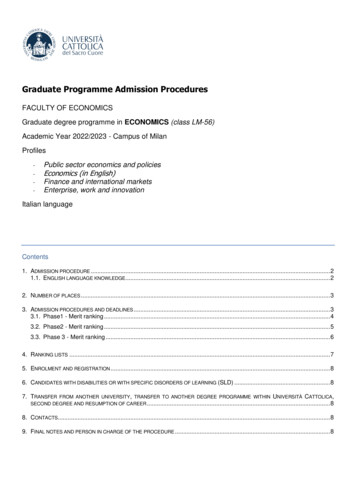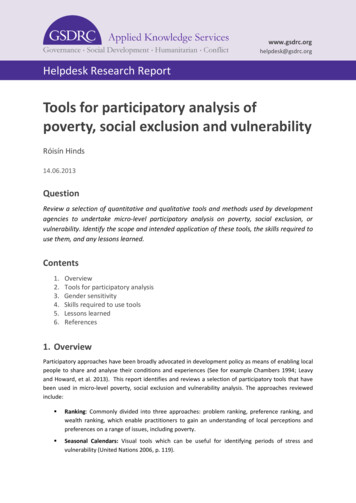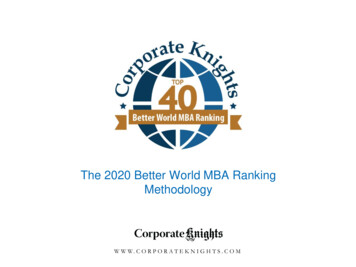
Transcription
The 2020 Better World MBA RankingMethodologyW W W. C O R P O R A T E K N I G H T S . C O M
Better World MBA Ranking: fast factsOverviewEligibility Annual ranking of MBA programssustainability performance Size: All business schools in the most recentFT100 MBA Ranking and the Top 40 from the2019 Better World MBA ranking areautomatically included. All business schoolsaccredited by either one of AMBA, AACSB orEQUIS and all current PRME Champions areinvited (and communicate their participation onan opt-in basis). Released each fall in Corporate KnightsMagazine and www.corporateknights.com.ApproachContact info and to learn more Ranking is based on publicly-disclosed data(e.g., school’s website, academic journals,Google Scholar, general internet searches). Allrequired datapoints are pre-populated.Submissions from schools are not required butyour review is kindly requested. Email research@corporateknights.com if youwould like to confirm the correct contacts foryour organization Sign up for email updates on future rankingsand research from Corporate Knights. Methodology is based on the 5 keyperformance indicators (KPIs).1
Ranking is conducted by Corporate Knights, a specializedmedia and investment research firmCorporate Knights is a Toronto-based, employee-owned B Corp that operates in three segments:– Corporate Knights Magazine World's largest circulating magazine focused on sustainability and responsible business. Reaches 443,250 of the world’s most influential business and political decision-makers.– CK Research CK Research offers a range of corporate sustainability ratings, investment product ratings andtools. CK Research also manages several external research projects (e.g. Carbon Clean 200,Sustainable Stock Exchange Ranking, Global Green Financial Index).– Council for Clean Capitalism CEO-supported group catalyzing smart and efficient public policy. Engages with leading public policy-makers.2
Philosophical perspective of the ranking Relevance: The ranking is meant to be representative of sustainability leadership inthe current socio-economic context. Transparency: The precise methodology of the ranking and the results of theprocess are fully disclosed. Objectivity: Eligible entities are assessed using quantitative data and performanceindicators. Public data: Only data-points that are part of the public domain are used. Engagement: Entities eligible for the ranking are informed prior to the ranking, soas to have an opportunity to ensure the necessary data is accurate and madeavailable publicly. Stakeholders: Stakeholder feedback is actively solicited throughout the project. APanel of Experts, consisting of several sustainability practitioners, review andcomment on all aspects of the methodology.3
Key Performance IndicatorsKPIMethodologyWe count the proportion of your core (mandatory) courses from your full-time MBA program that integrate relevantsustainable development. themes This is determined by looking at the course description available on theprogram’s website.Core Courses (weight: 30%)See list of topics considered as part of “sustainable development” mAvkJeQbBep1C8 L8GCcCEYJeH0 guezA9fBt0/edit#gid 0Notes:1. Where schools have multiple MBAs: We will research the core courses for a second MBA program only if:-The school offers both a Sustainability MBA program (NOTE: Not a sustainability specialization or stream within a generic MBA program) inaddition to a generic MBA program; ANDThe latest student intake for the generic MBA program is higher than that of the Sustainability MBA program.In the above case, we will research the core courses of the Sustainability MBA program (weighted: 50%) and that of the generi c MBA program(weighted: 50%).Therefore, if a school offers both a generic MBA program and a Sustainability MBA program, and the Sustainability MBA program has the higheststudent intake, then we will research only one MBA program: the Sustainability MBA program.Note: A “generic” MBA program would include any non-Sustainability MBA programs, such as the “full-time” MBA, “international MBA”, “professional”MBA etc. Where a school offers several generic MBAs, research is to be conducted on the one with the highest student intake only.2. Core courses are scored “1” if it is fully or substantially dedicated to areas of sustainable development. A score of “0.5” is given in cases where thecourse only partially covers any of the areas of sustainable development.4
Key Performance IndicatorsKPIResearch Institutes andcentres(weight: 10%)MethodologyWe count the number of research institutes and centres (regardless of location, sponsored or run in partnershipwith another school) out of a maximum of five that are fully or substantially dedicated to areas of sustainabledevelopment. This is determined by looking at the areas of research for any given institute and centre that isavailable on the school’s website.See list of topics considered as part of “sustainable development” mAvkJeQbBep1C8 L8GCcCEYJeH0 guezA9fBt0/edit#gid 0Note:1. A research institute and centre is scored “1” if it is fully or substantially dedicated to areas of sustainable development. A score of “0.5” is given incases where it also covers other areas of research that are not within the list of sustainable development topics.5
Key Performance IndicatorsKPIMethodologyThe number of peer-reviewed publications in academic journals in 2019 (calendar year) authored or co-authoredby a faculty member of the business school and the number of citations that are considered as part of “sustainabledevelopment”.Please Note: we use Google Scholar to score for citations. If your publication is not on Google Scholar, pleaseprovide evidence that the source is peer-reviewed or other justification for why the publication should be counted.Faculty research intensity(weight: 30%) and number ofcitations intensity (weight:20%)See list of topics considered as part of “sustainable development” here (note articles falling outside below keywords but within the spirit of “sustainable development” should be k29dEmAvkJeQbBep1C8 L8GCcCEYJeH0 guezA9fBt0/edit#gid 0The faculty research intensity is: Number of peer-reviewed publications in academic journals in 2019 that wasauthored or co-authored by a faculty member of your business school that are considered as part of “sustainabledevelopment”/Total number of faculty members*.The number of citations intensity is the sum of number of citations for all peer-reviewed publications in academicjournals in 2019 that was authored or co-authored by a faculty member of your business school that areconsidered as part of “sustainable development”/(Total number of faculty members*.x 10).* The list of your faculty members is sourced from your school’s website. Any full-time faculty (professor, lecturer, associate or adjunct) counts as 1;any visiting or part-time faculty counts as “0.5”.6
Key Performance IndicatorsKPIMethodologyFaculty gender diversity(weight: 5%)The percentage of faculty members who are women out of the total number of faculty members. The list of yourfaculty members is sourced from your school’s website*.Faculty racial diversity(weight: 5%)Numerator: Percentage of the school’s faculty members who can be identified by photo, name and or biographyas clearly not part of the country’s majority race or ethnic group**. The main visible races or ethnicities regardlessof place of birth or citizenship are***:1. White2. Black3. Chinese4. Filipino5. Japanese6. Korean7. South Asian-East Indian (including Indian from India; Bangladeshi; Pakistani; East Indian fromGuyana, Trinidad, East Africa; etc.)8. Southeast Asian (including Burmese; Cambodian; Laotian; Thai; Vietnamese; etc.)9. Non-white West Asian (includes Turkey, Middle East and Caucasus)10. North African or Arab (including Egyptian; Libyan; Lebanese; etc.)11. Non-white Latin American (excluding indigenous persons from Central and South America, etc.)Denominator: % of school’s country population not part of the country's majority racial group. A break-down ofmajority racial groups by country is available 7V6J7fCZ09uZgQhIAil8pPEI-ZJtqmeAes/editNote: Any full-time faculty (professor, lecturer, associate or adjunct) counts as 1; any visiting or part-time faculty counts as “0.5”.* Research done during the months of May and June 2020. Please note, for privacy reasons, schools are not provided with nor asked toverify this data.** To avoid perpetuating historical privilege, scoring does not count faculty members from any racial group(s) that comprises 50% or greaterglobal share of all non majority racial group faculty members.*** http://www23.statcan.gc.ca/imdb/p3Var.pl?Function DEC&Id 451527
Corporate Knights Notice and DisclaimerThis document and all of the information contained in it, including without limitation all text, data, graphs, charts (collectively, the“Information”) is the property of Corporate Knights Inc. known herein as “Corporate Knights” and is provided for informational purposesonly. The Information may not be modified, reverse-engineered, reproduced or redisseminated in whole or in part without prior writtenpermission from Corporate Knights.The Information may not be used to create indexes, databases, risk models, analytics, software, or in connection with the issuing,offering, sponsoring, managing or marketing of any securities, portfolios, financial products or other investment vehicles utilizing orbased on, linked to, tracking or otherwise derived from the Information or any other Corporate Knights data, information, products orservices.The user of the Information assumes the entire risk of any use it may make or permit to be made of the Information. CORPORATEKNIGHTS DOES NOT MAKE ANY EXPRESS OR IMPLIED WARRANTIES OR REPRESENTATIONS WITH RESPECT TO THEINFORMATION (OR THE RESULTS TO BE OBTAINED BY THE USE THEREOF).Information containing any historical information, data or analysis should not be taken as an indication or guarantee of any futureperformance, analysis, forecast or prediction. Past performance does not guarantee future results.None of the Information constitutes an offer to sell (or a solicitation of an offer to buy), any security, financial product or otherinvestment vehicle or any trading strategy.The Information may contain back tested data. Back-tested performance is not actual performance, but is hypothetical. There arefrequently material differences between back tested performance results and actual results subsequently achieved by any investmentstrategy.Constituents of Corporate Knights equity indexes or stock lists are listed companies, which are included in or excluded from theindexes or lists according to the application of the relevant methodologies. Accordingly, constituents in Corporate Knights equityindexes or lists may include Corporate Knights, clients of Corporate Knights or suppliers to Corporate Knights. Inclusion of a securitywithin a Corporate Knights index or list is not a recommendation by Corporate Knights to buy, sell, or hold such security, nor is itconsidered to be investment advice.Corporate Knights receives compensation in connection with licensing its indexes to third parties. Corporate Knights Inc.’s revenueincludes fees based on assets in Index Linked Investments.Any use of or access to products, services or information of Corporate Knights requires a license from Corporate Knights. CorporateKnights brands and product names are the trademarks, service marks, or registered trademarks of Corporate Knights and itssubsidiaries in Canada, United States and other jurisdictions.8
3 Relevance: The ranking is meant to be representative of sustainability leadership in the current socio-economic context. Transparency: The precise methodology of the ranking and the results of the process are fully disclosed. Objectivity: Eligible entities are assessed using quantitative data and performance indicators. Public data: Only data-points that are part of the public domain are used.
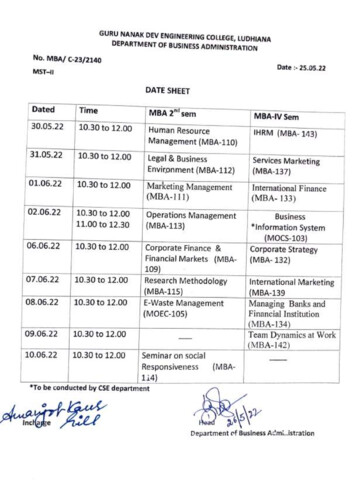


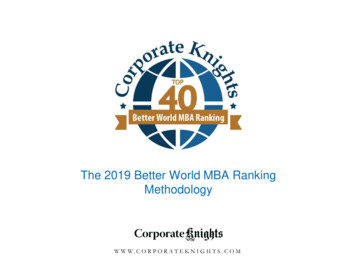
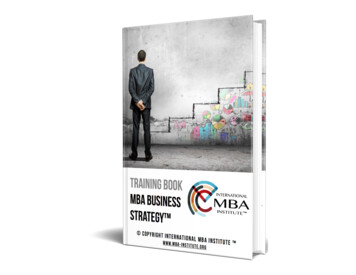
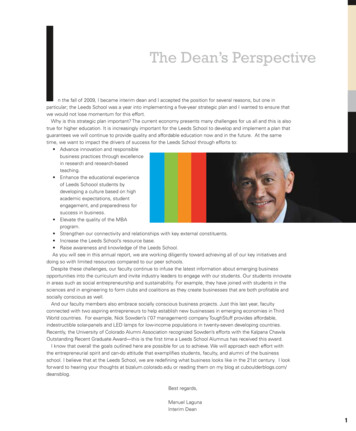

![GLOBAL MASTER IN BUSINESS ADMINISTRATION [GMBA]](/img/9/cat-p-192-i.jpg)
